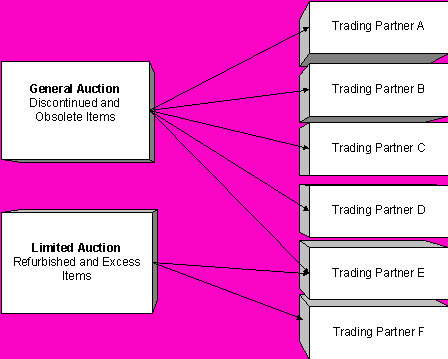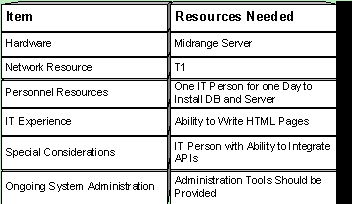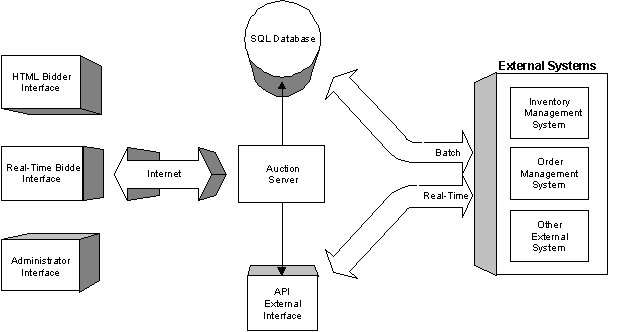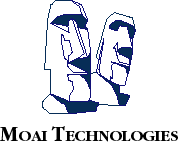
Getting Started with Business-Critical Auctioning
An Introduction To Online Auctions
A White Paper by Moai Technologies
Getting Started with Business-Critical Auctioning
Online auctions have rapidly become one of the most successful forms of electronic commerce. Implementing an online auction via an extranet allows companies to create a new and effective sales channel: a virtual private marketplace. The combination of administrative cost savings and higher revenues that result from the auction format creates a compelling and rapid return on investment. Through automated negotiations, online auctions allow companies to rapidly move inventory at true market prices while maintaining brand identity and minimizing channel conflict. To successfully take advantage of this type of system, a company must evaluate a number of factors. First and foremost, the company must understand its market and its customer. Once this review is complete, the appropriate software must be selected and implemented. Finally, the deployed system needs to be marketed to the customer group and introduced. This paper outlines these steps in more detail and highlights the key considerations involved in each step.
Understanding the Market and Customer
The first step to successfully getting started with business-critical auctioning is to understand the market and the customers that will be participating in the auction. Rather than undertake a major analysis of existing customers, the company need only review its understanding of its various customer types and their purchasing habits. Later, the deployment of an online auction system will help the company gain a more thorough understanding of the customer base, as information about their buying habits accumulates in the auction system database. To determine the most effective approach in creating an auction marketplace, the business unit developing the auction sales channel must examine the following key factors:• Amount and type of inventory available
• Number of trading partners participating
• Type of customer participating
• Revenue and inventory movement goals
Identifying the
amount and type of inventory to be sold is crucial in determining how to effectively
divide the items into separate auctions and categories, and how to best segment
the users into competitive groups of bidders. Companies often give large groups
of trading partners access to participate in specific auctions of discontinued
and obsolete items, while limiting auctions of refurbished and excess new products
to selected groups of bidders. Thus, companies are able to take advantage of
the competitive bidding dynamics of the auction, while minimizing channel conflict.

Figure 1. Trading Partners and Auction Visibility
Based on the customer group, the auction can be tailored to best suit the customer's needs. Professional users, such as brokers or inventory liquidators, require a real-time interface and an efficient way to handle their portfolio of bids. Typically, these users will be actively bidding until the closing of auctions. Users who are merely interested in reduced prices or want to fill some inventory shortages will probably be less active and take advantage of automated notifications and proxy bidding features that allow them to minimize the amount of time spent in the auction.
Auctions can be set up differently based on distinct objectives, such as maximizing revenue or rapidly liquidating inventory. In general, auctions consisting of a limited number of items and running for relatively long amounts of time will lead to the highest revenues. Auctions consisting of larger lot sizes that are open for shorter time periods allow large amounts of inventory to be efficiently liquidated very rapidly. Different auction formats also impact the results of an auction. A format such as the traditional ascending-price English auction can be extended to run for as long as bidding activity continues, leading to maximized revenues. A descending-price Dutch format can be used when it is desirable to have the auction completed in a short time period.
In-House vs. Out-Sourced Auction Service
A question that often arises is whether to run an auction in-house or to use an out-sourced auction service. Typically, companies that have to move large amounts or large dollar volumes of inventory, will find it more cost-effective to run the auctions themselves, while companies with small amounts of inventory often benefit more from an auction service. Auction services are also a good outlet for companies that do not have regular inventory management issues, but occasionally have goods to move via an auction sales channel. Companies often find that the high commissions charged by auction outsourcing services offset the increased revenues generated in the auction, and ultimately lead to the same net results as selling through traditional broker and liquidator channels. These companies choose to run their own auctions to maximize the revenue gains. Also, companies often choose to restrict the auction participants to existing trading partners by hosting the auction in-house to maintain full control and avoid revealing proprietary customer lists to third parties. Additionally, companies that want to use their auction as a way to better understand their customers often run auctions in-house in order to have full access to the data generated by the auction bidders. This data can be analyzed to determine purchasing habits of customers, as well as to view trends occurring during the auctions.Software Selection Criteria
A key element in the success of the auction is making sure that the online auction software suits the needs of the customer base without being an administrative burden for the company. When evaluating auction software, there are a number of important factors to consider that can ensure a higher degree of success in the online auction. These include the following:• Enterprise-level architecture
• Features of the auction application
• Flexibility in customizing and integrating the software
• Resources required to implement the system
Perhaps the most important consideration when selecting a mission-critical piece of software that will be used to interact with customers is that the underlying technical architecture of the software is of enterprise-level caliber. Most enterprise-level Internet applications employ a multi-tier architecture to minimize the potential of performance bottlenecks within the system, while maintaining high levels of flexibility. This type of architecture typically separates the application into multiple layers to handle data management, business rules, and graphical display of information. Each of these layers can be optimized by employing techniques, such as caches and queue-based communication, which allow the system to handle bursts of activity in the individual layers of the architecture without slowing down the whole system. Bidding is not only the most complex process in the system, but also the most crucial to log correctly in the database. Due to its complexity and importance, bidding capacity of the application is a specific facet that should be addressed in Internet auction systems. The application should employ a queue-based system that allows large numbers of bids to be submitted during periods of peak activity. It is also important to look at how many bids can be completely processed in a given time period. Complete processing of a bid involves accepting the bid, processing it, and logging the transaction completely in the database. The number of bids that can be processed in a given time period is crucial to the success of an online auction.
Ideally, the architecture should interact with industry standard relational databases and contain a published database schema, which allows for easy sharing of data with other applications and facilitates analysis of the auction data. The architecture should also include open APIs that allow the software to be integrated with other in-house applications such as inventory management, order processing, and accounting packages. An additional advantage to a well-designed, extensible, and open architecture is that this type of software is much easier to modify with the latest auction formats and enhancements.
Most commercial
auction applications will share a common set of basic features. However, if
the customer base consists of a large number of professional users that use
inventory auctions as a key procurement method within their businesses, it is
crucial that the software meets their specialized needs. Those needs include
real-time updating capabilities and portfolio screens that facilitate easy management
of bids in multiple, simultaneous auctions.
Security is another
key consideration in any Internet-commerce application. Online auction systems
must allow for communications to be encrypted using
industry
standard SSL with strong encryption, such as RSA. A flexible security model
for assigning user rights is also important. Auction software should let
the
administrator set security for individual users and groups, allowing different
levels of access to the system. This includes setting security that allows
users
and groups access to specific sets of auctions within the system. This type
of security model allows an administrator to develop highly focused groups
of
auctions and users. This focus helps eliminate channel conflict and allows
for effective targeted marketing of the auctions.
Flexibility is always a key consideration in auction software. The user interface of the system should be easy to customize and brand with the company's identity, without limiting the flexibility in designing the look and feel of the system. The auction formats themselves should be based on a set of parameters that the administrator can easily modify, including the conditions upon which the auction will close.
An important final
consideration in selecting auction software is the amount of resources required
to deploy, customize, and maintain the auction system. Hardware and network
resources required for an auction system vary based on the volume of activity
on the system, but many companies will find a mid-range server and T1 network
connectivity sufficient for their needs. Personnel resources should also be
minimal, as the auction system should be highly automated. Standard installation
requires an IT resource for a day or so to install the database and auction
server. As these products typically have wizard-based installation programs,
experienced personnel are usually not required. System customization will take
approximately the same amount of resources as is required to design a web site,
which will vary based on the sophistication of the site.

Figure 2. Required Resources
The technical expertise required should not go beyond the ability to write HTML pages. However, if one utilizes the APIs to integrate the auction software with existing legacy systems, more experienced technical resources will be required in customizing auction software. Ideally, the software should be fully functional without requiring that type of integration. Finally, the ongoing auction system administration should be as simple and automated as possible. Administration tools should allow clerks to easily enter inventory data into the auction based upon business rules put in place by the business unit managing the movement of the inventory.
Implementing an Online Auction System
Once the appropriate auction software has been selected, it is important to make sure that the software will smoothly integrate with existing business processes. This integration process can be performed either internally or using an outside integration firm. Deploying an auction system is similar to integrating any enterprise application. One must define the resources, procedures, and interfaces required to accommodate the new system. The data flows must be understood and any new programs or processes must be designed, implemented, and tested. The effort required is dependent mainly on the level of customization and automation required to support the auction system. A high-level work plan for implementing an auction system includes the following steps:• Identify and train resources
• Install and configure the software
• Design and implement the web site
• Design and implement supporting interfaces
• Test the system
While there are some basic dependencies between these steps, many of the details can be carried out simultaneously.
As with any enterprise application, it is necessary to have internal resources that can administer the auction software. Ideally, the software will contain an easy to use graphical administration tool. Administration should take minimal effort and minimal training, allowing existing personnel to be quickly trained on the product. Most auction software requires three primary roles: a system administrator to install and configure the software, a data administrator to maintain the data in the auction system, and content administrator to customize the templates in order to provide the look and feel of the auction site. None of these roles should be full-time, and, in many cases, the same person can perform more than one role. The important aspect of this step is to identify the resources and ensure they have the proper training.
Online auction software should support a wide range of platforms and databases so that the software conforms to the existing standards in the organization. This will eliminate the need to adopt new standards and technologies to support the auction system, as well as reduce the amount of training required to implement the system.
The next step is designing the look and feel of the site. This process is often led by the business unit responsible for the inventory and may involve the company's marketing group and/or web group. Companies will often contract the overall look and feel to a design company. By using standard design templates, the content administrator can easily add the auction data. The most flexible auction systems support an HTML pass-through template architecture rather than rigid structured template design. This allows for the highest degree of customization and branding.
While the software
is being installed and the web site is being developed, the organization should
focus on data flows required for the new system. It is important to understand
how inventory items and customers will flow into the auction system. It is also
important to understand how orders for items will be fed back to existing systems
for organizations that wish to integrate the auction system with existing systems.
A true enterprise-level system will allow the data flows to be handled in several
ways. Depending on the level of automation required, the system should allow
manual processes or automated processes. The more sophisticated auction systems
will allow automation either through access to the system's database or through
an open API. Once the data flows are understood, the organization can define
the manual processes or implement the automated processes and integrate them
into the existing environment.

Figure 3: Auction System Architecture
Once the site design has been approved and initial customizations made, a small group of users should be consulted to gauge the design's visual effectiveness, the level of user friendliness, and general usability. Following this initial approval testing, there is typically a round of final user interface approval by the business unit deploying the system and the marketing group. After the design is approved, the functionality of the site should be tested internally to make sure everything is functioning correctly. All aspects of the system should be tested including the manual and automated processes. Each component of the workflow, from inventory entry to fulfillment, should be thoroughly tested. All reports created to analyze the system bidding patterns and trends should also be run and examined for suitability of use at this time. The system should also be tested under expected peak user loads and data volumes.
After internal testing is complete, a small favored group of customers can be selected to participate in a pilot test of the online auction site. This often consists of the top 10% of a company's trading partners, who are given exclusive access to the initial auctions. The pilot test is often a user-acceptance test. Comments from this user group will help determine final modifications to the site's navigation, content, and usability.
Marketing and Rolling out the Online Auction
After the system has been successfully beta tested, it is time to publicly market the site. This is usually done by sending out initial emails with account information, such as user IDs and passwords, to the full group of trading partners that will participate in the auctions. Creating a special event or promotion is instrumental in driving widespread participation in the initial auctions. This can be done by using the auction as an exclusive distribution channel for certain types of sought after inventory, or perhaps by giving some premium for participation in the auction. Once the initial marketing push has been made, it is advisable to create regular auction schedules that allow people to make the auction a regular part of their business practices. Auction software should also have automated email systems that allow for notifications without ongoing marketing costs. It is crucial that the auction software allows for analysis of the bidding patterns and trends within the auctions, as this data can be utilized to make subsequent auctions more effective. As the auction becomes more successful, additional marketing and promotion is often useful to increase the size of the trading group. For example, while only registered trading partners may participate in an auction, a company can open up the auction for additional partners to view. This can entice them into a new level of association with your company. The automated software allows for efficient communication with large groups of partners, thus ensuring the company achieves its goals.When the system has been fully tested and an initial marketing program executed, it is time to go live with the site to the entire customer group. From that point on, the most critical factor is the ease of ongoing administration. It is important to make sure the software includes simple administration tools that allow new auctions to be easily added to the system on a continual basis.
Conclusion
Online auctions present a new web-based channel for companies that have excess inventory and asset management challenges. A virtual private marketplace offers forward thinking companies many compelling business advantages, including:• A rapid return on investment
• Maximized revenues through competitive bidding
• Creation of a bidding history database for use in one-to-one marketing
• Minimized sales channel conflict
• Preservation and strengthening of the company brand
• Reduction in administrative costs
Careful consideration should also be given to the criteria for evaluating online auction software. Among these are the enterprise-level architecture, the flexibility of the system, the 'must-have' features in the auction application, and the resource commitment required to administer and maintain the system.
Developing the right online auction system that is customized for a company's needs and customer base will create a powerful sales channel with a rapid return on investment. By taking into consideration each of the steps documented in this paper, companies can create a truly successful online auction environment.
For more information on online auctions, call Moai Technologies at (415) 625-0601.

Copyright 1998, All rights reserved by Moai Technologies, Inc.
Moai Technologies
25 Lusk Street
San Francisco, CA 94107
Telephone: (415) 625-0601
Fax: (415) 625-1200
21st, The VXM Network, https://vxm.com